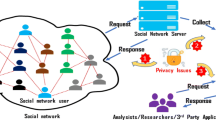Abstract
The widespread use of mobile devices in digital community has promoted the variety of data collecting methods. However, the privacy of individuals plays an important role in data processing or data transmission, and such information should be protected. In this paper, (α, k)-anonymity model, a widely used privacy-preserving model, is adopted as a security frame. Then, a privacy-preserving data collection model ((α, k))-CM based on (α, k)-anonymity is proposed and the threat model is analyzed. To resist the possible attack, we propose a generalization-encryption method to achieve a desired privacy level in (α, k)-CM. Generalization can decrease the data size and save the resource might induce information loss in data process; while encryption can decrease information loss, however, it can cause the waste of resource. Generalization-encryption method dynamically encrypts a portion of the data with maximum information loss and adjusts the portion to balance the trade-off metric in the process of generalization. Experimental results and theoretical analysis show that this method is effective in terms of privacy levels and data quality with low resource consumption.
Similar content being viewed by others
References
Lakshmi S, Ramesh P S. Secure encrypted-data routing protocol for wireless sensor networks. J Comput Appl, 2012, 5: 167–173
Kumar S, Dohare D, Kumar M. An efficient key distribution scheme for wireless sensor networks using polynomial based schemes. In: Proceeding of the 2012 International Conference on Information and Network Technology, Singapore, 2012. 21–27
Chen C, He D J, Chan S, et al. Lightweight and provably secure user authentication with anonymity for the global mobility network. Int J Commun Syst, 2011, 24: 347–362
Tseng Y M, Huang Y H, Chang H J. Privacy-preserving multireceiver ID-based encryption with provable security. Int J Commun Syst, 2014, 27: 1034–1050
Zhang T, Ma J F, Li Q, et al. Trust-based service composition in multi-domain environments under time constraint. Sci China Inf Sci, 2014, 57: 092109
Fung B C M, Wang K, Chen R, et al. Privacy-preserving data publishing: a survey on recent developments. ACM Comput Surv, 2010, 42: 1–14
Sridhar V, Raghavendar V. Key predistribution scheme for grid based wireless sensor networks using quadruplex polynomial shares per node. Procedia Comput Sci, 2011, 5: 132–140
Lee E, Park S, Lee J, et al. Novel service protocol for supporting remote and mobile users in wireless sensor networks with multiple static sinks. Wirel Netw, 2011, 17: 861–875
Boulfekhar S, Bouallouche L, Benmohammed M. S-TDMA: a new MAC protocol for wireless sensor networks. In: Proceeding of 2012 IEEE/ACM 16th International Symposium on Distributed Simulation and Real Time Applications, Dublin, 2012. 29–35
Sweeney L. Achieving k-anonymity privacy protection using generalization and suppression. Int J Uncertainty Fuzziness Knowl-Based Syst, 2002, 10: 571–588
Xiao X K, Tao Y F. Personalized privacy preservation. In: Proceeding of the ACM International Conference on Management of Data (SIGMOD), Chicago, 2006. 229–240
Iyengar V S. Transforming data to satisfy privacy constraints. In: Proceeding of the 8th ACM International Conference on Knowledge Discovery and Data Mining, Edmonton, 2002. 279–288
Meyerson A, Williams R. On the complexity of optimal k-anonymity. In: Proceeding of the 23rd ACM SIGMODSIGACTSIGART Symposium on the Principles of Database Systems. New York: ACM, 2004. 223–228
Lind J C, Wiens D P, Yohai V J. Robust minimum information loss estimation. Comput Stat Data Anal, 2013, 65: 98–112
Gionis A, Tassa T. k-anonymization with minimal loss of information. IEEE Trans Knowl Data Eng, 2007, 21: 206–219
Tar P D, Thacker N A, Jones M A, et al. A quantitative approach to the analysis of planetary terrains. In: Proceeding of the Remote Sensing and Photogrammetry Society Conference, London, 2012. 1–4
Fung B C M, Wang K, Yu P S. Top-down specialization for information and privacy preservation. In: Proceeding of the 21st IEEE International Conference on Data Engineering, Tokyo, 2005. 205–216
Fung B C M, Wang K, Yu P S. Anonymizing classification data for privacy preservation. IEEE Trans Knowl Data Eng, 2007, 19: 711–725
Jin X, Zhang N, Das G. Algorithm-safe privacy preserving data publishing. In: Proceeding of the 13th International Conference on Extending Database Technology. New York: ACM, 2010. 633–644
Jin X, Zhang N, Das G. ASAP: eliminating algorithm-based disclosure in privacy-preserving data publishing. Inf Syst, 2011, 36: 859–880
Cox L H. Suppression methodology and statistical disclosure control. J Am Stat Assoc, 1980, 75: 377–385
Chaum D. The dining cryptographers problem: unconditional sender and recipient untraceability. J Cryptology, 1988, 1: 65–75
Chaum D. Untraceable electronic mail, return addresses, and digital pseudonyms. Secur Electron Voting Adv Inf Secur, 2003, 7: 211–219
Edith C H, Rodhe N I. On providing location privacy for mobile sinks in wireless sensor networks. Wirel Netw, 2013, 19: 115–130
Nacher M, Calafate C T, Cano J C, et al. An overview of anonymous communication in mobile ad hoc networks. Wirel Commun Mob Comput, 2012, 12: 661–675
Gedik B, Liu L. Protecting location privacy with personalized k-Anonymity: architecture and algorithms. IEEE Trans Mob Comput, 2008, 7: 1–18
Gurjar A, Patial A R B. Evaluating the privacy measure of the source location privacy scheme in a wireless sensor network. Int J Comput Eng Res, 2013, 3: 10–13
Xie H, Kulik L, Tanin E. Privacy-aware collection of aggregate spatial data. Data Knowl Eng, 2011, 70: 576–595
Author information
Authors and Affiliations
Corresponding author
Rights and permissions
About this article
Cite this article
Li, H., Ma, J. & Fu, S. A privacy-preserving data collection model for digital community. Sci. China Inf. Sci. 58, 1–16 (2015). https://doi.org/10.1007/s11432-014-5197-2
Received:
Accepted:
Published:
Issue Date:
DOI: https://doi.org/10.1007/s11432-014-5197-2





